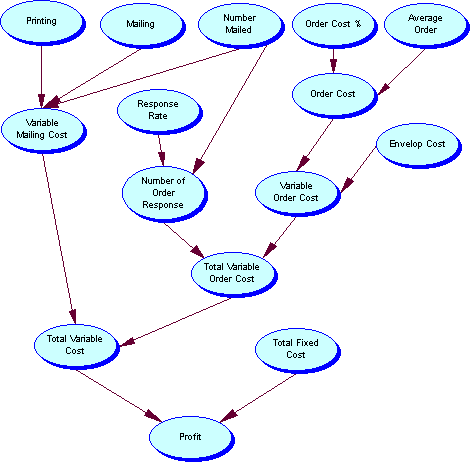Guolin Lai
DSC8240 Course Web
Personal Statement
Chapter 1 Summary
Chapter 2 Report
Breakeven Analysis
Price & Demand Relationship
Quantity Discounts Decision
Hedging Investment Risk
Time Value of Money
Enterprise DSS
Time Series Forecasting
DSS Development Project
Simulation Model Examples
Government Contract Bidding
GFAuto Model
Customer Loyalty
Game of Craps
Monte Carlo Simulation
Optimization Modeling
Term Project
Business Intelligence Research
Background
Objective Hierarchies
Variables and Attributes
Influence Diagram
Mathematical Representation
Testing and Validation
Implementation and Use
Background
The Great Threads Company sells hand-knit sweaters. It is planning to
print a brochure of its products and undertake a direct mail campaign.
The cost of printing the brochure is $20,000 plus $0.10 a catalog. The
cost of mailing each catalog is $0.15. In addition, the company will include
direct reply envelopes in it’s mailings. It incurs $0.20 in extra
cost for each direct mail envelope that is used by a respondent. The average
size of a customer order is $40, and the company’s variable cost
per order averages around 80% of the order’s value. The company plans
to mail 100,000 catalogs.
Objective
Hierarchies
The company plans to mail 100,000 catalogs. It wants to develop a spreadsheet
model to answer the following questions:
- How does a change in the response rate affect profit?
- For what response rate does a company break even?
- If the company estimates a response rate of 3%, should it proceed with the mailing?
- How does the presence of uncertainty affect the usefulness of the model?
|
Variable
|
Variable Type
|
How Measured
|
Related to
|
| Fixed cost of printing | Input Variable | Total Amount in $ | Fixed Cost |
| Printing Cost | Input Variable | $0.10 per catalog | Variable Mailing Cost |
| Mailing Cost | Input Variable | $0.15 per catalog | Variable Mailing Cost |
| Number Mailed | Input Variable | Total Amount in Numeric | Variable Mailing Cost & Number of Order Response |
| Average Order | Input Variable | Amount per order in $ | Order Cost |
| Order Cost % | Input Variable | % of order | Order Cost |
| Envelope Cost | Input Variable | $ | Variable Order Cost |
| Response Rate | Decision Variable | % | Number of Order Response |

Mathematical
Representation
Number of Responses = Number Mailed * Response Rate;
Revenue = Number of Responses * Average Order;
Variable Cost from Mailing = SUM(Variable Cost of Mailing) * Number Mailed;
Variable Cost from Ordering = Number of Responses * (Average Order * Variable
Cost % of Order + Variable Cost of Envelopes);
Total Cost = Fixed Cost of Printing + Variable Cost from Mailing + Variable
Cost from Ordering
Profit = Revenue - Total Cost.

How does a change in the response rate affect profit?
Clearly, profit increases in a linear manner as response rate varies.
More specifically, a 1% increase in the response rate always increased
profit by $7800. Here is the reasoning. Each 1% in response rate results
in 100,000 x 0.01=1000 more orders. Each order yields an average revenue
of $40 but incurs a variable cost of $40 x 80% = $32 and a $0.20 envelope
cost. The net gain is $7.80 per order, or $7800 for 1000 orders. From
the data table, we see that profit goes from negative to positive when
the response rate is somewhere between 4% and 5%.
For what response rate does a company break even?
This could be found with trial and error but is easy with Excel’s Goal Seek tool. If the response rate is 5.77% Great Threads breaks even. If the response rate is greater then 5.77%, the company makes money; otherwise, it loses money.
If the company estimates a response rate of 3%, should it proceed with the mailing?
From the data table, the apparent answer is " no" because profit is negative, a loss. However, if we look at long-term impact of the decision, the answer will be " yes " --- if customers who respond to direct mail will reorder in the future and thus the company will achieve a positive profit. If we want to incorporate the long term explicitly into the model, we must build a more complex model.
How does the presence of uncertainty affect the usefulness of the model?
When there is a high degree of uncertainty about model inputs, it makes
little sense to talk about the profit level or the breakeven response
rate. It makes more sense to talk about the probability that profit will
have a certain value or the probability that the company will break even.
The model can be manipulated in Microsoft Excel.